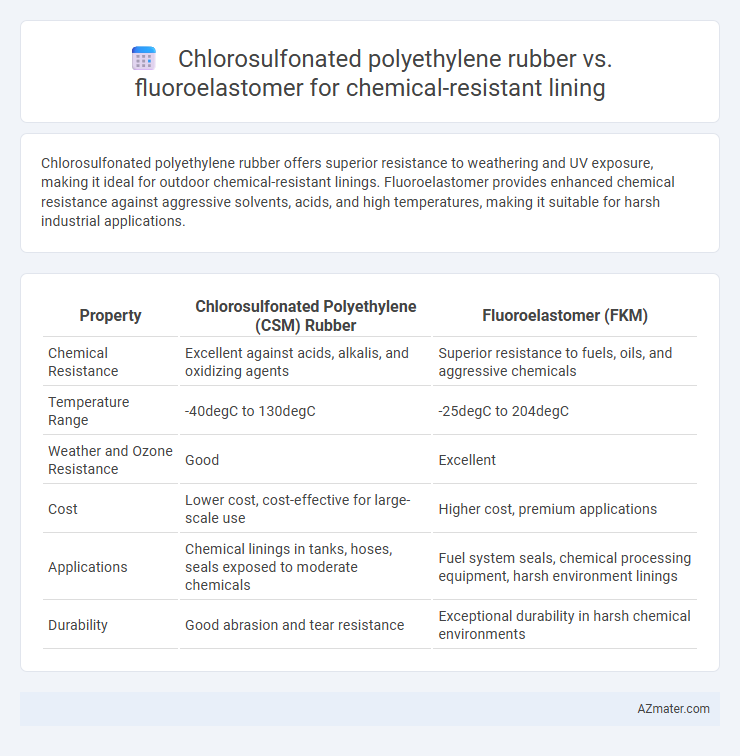Chlorosulfonated polyethylene rubber offers superior resistance to weathering and UV exposure, making it ideal for outdoor chemical-resistant linings. Fluoroelastomer provides enhanced chemical resistance against aggressive solvents, acids, and high temperatures, making it suitable for harsh industrial applications.
Table of Comparison
| Property | Chlorosulfonated Polyethylene (CSM) Rubber | Fluoroelastomer (FKM) |
|---|---|---|
| Chemical Resistance | Excellent against acids, alkalis, and oxidizing agents | Superior resistance to fuels, oils, and aggressive chemicals |
| Temperature Range | -40degC to 130degC | -25degC to 204degC |
| Weather and Ozone Resistance | Good | Excellent |
| Cost | Lower cost, cost-effective for large-scale use | Higher cost, premium applications |
| Applications | Chemical linings in tanks, hoses, seals exposed to moderate chemicals | Fuel system seals, chemical processing equipment, harsh environment linings |
| Durability | Good abrasion and tear resistance | Exceptional durability in harsh chemical environments |
Introduction to Chemical Resistant Linings
Chemical resistant linings provide essential protection for industrial equipment exposed to aggressive chemicals and harsh environments. Chlorosulfonated polyethylene rubber (CSM) offers excellent resistance to acids, alkalis, and ozone, making it a cost-effective choice for chemical containment. Fluoroelastomers (FKM) deliver superior chemical stability and high-temperature resistance, ideal for handling aggressive solvents, fuels, and chlorinated compounds in demanding applications.
Overview of Chlorosulfonated Polyethylene Rubber (CSM)
Chlorosulfonated polyethylene rubber (CSM) is a synthetic elastomer known for its exceptional resistance to chemicals, ozone, and weathering, making it ideal for chemical resistant lining applications. Its superior tensile strength, flexibility, and ability to withstand a wide range of aggressive chemicals, including acids, alkalis, and solvents, provide durability in harsh industrial environments. Compared to fluoroelastomers, CSM offers cost-effective protection with good resistance to hydrocarbon fuels, though it has lower thermal stability and resistance to highly concentrated acids.
Overview of Fluoroelastomer (FKM)
Fluoroelastomer (FKM) offers superior chemical resistance compared to Chlorosulfonated polyethylene rubber, excelling in environments with aggressive acids, fuels, and high-temperature hydrocarbons. FKM's molecular structure provides excellent thermal stability up to 200-250degC and outstanding resistance to oils, solvents, and oxidizing chemicals, making it ideal for chemical resistant linings. Its low permeability and durability extend service life in harsh industrial applications where chemical exposure is severe and continuous.
Chemical Resistance: CSM vs. FKM
Chlorosulfonated polyethylene (CSM) rubber exhibits excellent resistance to ozone, weathering, and a wide range of chemicals such as acids, bases, and salt solutions but shows limited performance against oils and hydrocarbons. Fluoroelastomer (FKM), known for superior chemical resistance, withstands aggressive fuels, solvents, and high temperatures, making it highly effective for lining applications exposed to harsh chemical environments. In chemical resistant lining, FKM generally outperforms CSM in resistance to petroleum-based chemicals, while CSM offers cost-effective protection against acids and alkalis.
Mechanical Properties Comparison
Chlorosulfonated polyethylene rubber (CSM) exhibits excellent abrasion resistance, tensile strength typically ranging from 10 to 22 MPa, and elongation at break between 200-400%, making it highly durable under mechanical stress. Fluoroelastomers (FKM), by contrast, offer superior tensile strength often exceeding 15 MPa, with elongation values around 150-300%, combined with exceptional resistance to compression set and higher temperature tolerance. The enhanced mechanical robustness of FKM ensures longer service life in chemically aggressive environments, while CSM provides cost-effective resilience against physical wear and tear in moderate industrial applications.
Temperature Resistance and Stability
Chlorosulfonated polyethylene rubber offers excellent chemical resistance with stable performance up to 150degC, making it suitable for moderate temperature applications. Fluoroelastomers provide superior temperature resistance, maintaining chemical stability and mechanical integrity in environments ranging from -26degC to 204degC. The high thermal stability of fluoroelastomers makes them ideal for aggressive chemical handling at elevated temperatures, outperforming chlorosulfonated polyethylene in stability and durability.
Installation and Processing Differences
Chlorosulfonated polyethylene (CSPE) rubber offers easier installation due to its higher flexibility and better elongation properties compared to fluoroelastomer, which is more rigid and challenging to handle. CSPE can be processed at lower temperatures using conventional methods such as extrusion and calendering, whereas fluoroelastomers require high-temperature vulcanization and specialized equipment for processing. These differences impact labor costs and installation time, making CSPE preferable for applications demanding quicker turnaround without compromising chemical resistance.
Cost and Availability
Chlorosulfonated polyethylene (CSM) rubber offers a cost-effective solution with broad chemical resistance and greater availability due to its widespread production and use in various industries. Fluoroelastomer (FKM) provides superior chemical resistance, especially against aggressive solvents and high-temperature fluids, but its higher material cost and limited suppliers increase overall expenses and lead times. Budget-sensitive projects with moderate chemical exposure often favor CSM, while critical applications requiring exceptional durability and resistance tend to invest in the pricier, less available fluorocarbon alternatives.
Typical Applications in Chemical Environments
Chlorosulfonated polyethylene rubber (CSM) excels in chemical-resistant linings for industrial tanks, pipes, and containment vessels exposed to mild acids, alkalis, and solvents due to its excellent resistance to weathering and ozone. Fluoroelastomers (FKM) are preferred in pharmaceutical, automotive fuel systems, and aerospace applications where exposure to aggressive chemicals, fuels, and high temperatures demand superior chemical resistance and thermal stability. Selecting between CSM and FKM depends heavily on the specific chemical environment, temperature requirements, and mechanical stress factors present in the application.
Choosing the Right Material for Chemical Lining
Chlorosulfonated polyethylene rubber (CSM) offers excellent resistance to weathering, ozone, and a broad range of chemicals such as acids, alkalis, and solvents, making it suitable for chemical-resistant lining in moderate chemical environments. Fluoroelastomer (FKM) exhibits superior chemical resistance against aggressive solvents, fuels, oils, and high temperatures, providing enhanced durability in highly corrosive and extreme conditions. Selecting the right material depends on the specific chemical exposure, temperature range, and mechanical stress, where CSM suits less aggressive chemicals and cost-sensitive applications, while FKM is preferred for harsh chemicals and demanding industrial environments.

Infographic: Chlorosulfonated polyethylene rubber vs Fluoroelastomer for Chemical resistant lining
 azmater.com
azmater.com